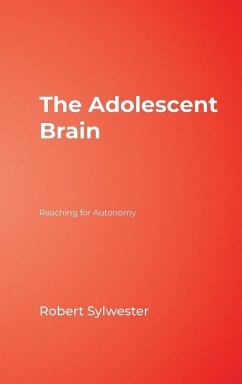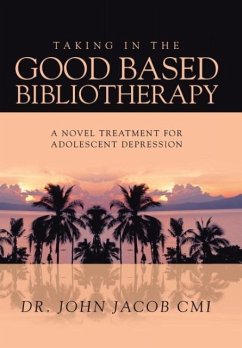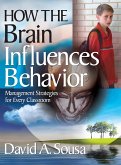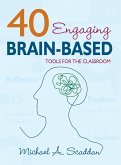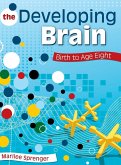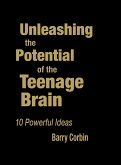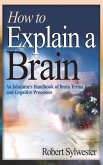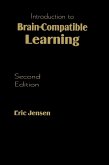- Gebundenes Buch
- Merkliste
- Auf die Merkliste
- Bewerten Bewerten
- Teilen
- Produkt teilen
- Produkterinnerung
- Produkterinnerung
Easy-to-understand theories and nontechnical language help educators and parents understand how the teenage brain thinks, feels, learns, and changes on its journey to adulthood.
Andere Kunden interessierten sich auch für
![TAKING IN THE GOOD BASED BIBLIOTHERAPY TAKING IN THE GOOD BASED BIBLIOTHERAPY]() John Jacob CmiTAKING IN THE GOOD BASED BIBLIOTHERAPY24,99 €
John Jacob CmiTAKING IN THE GOOD BASED BIBLIOTHERAPY24,99 €![How the Brain Influences Behavior How the Brain Influences Behavior]() David A. SousaHow the Brain Influences Behavior101,99 €
David A. SousaHow the Brain Influences Behavior101,99 €![40 Engaging Brain-Based Tools for the Classroom 40 Engaging Brain-Based Tools for the Classroom]() Michael A. Scaddan40 Engaging Brain-Based Tools for the Classroom86,99 €
Michael A. Scaddan40 Engaging Brain-Based Tools for the Classroom86,99 €![The Developing Brain The Developing Brain]() Marilee SprengerThe Developing Brain81,99 €
Marilee SprengerThe Developing Brain81,99 €![Unleashing the Potential of the Teenage Brain Unleashing the Potential of the Teenage Brain]() Barry CorbinUnleashing the Potential of the Teenage Brain71,99 €
Barry CorbinUnleashing the Potential of the Teenage Brain71,99 €![How to Explain a Brain How to Explain a Brain]() Robert SylwesterHow to Explain a Brain82,99 €
Robert SylwesterHow to Explain a Brain82,99 €![Introduction to Brain-Compatible Learning Introduction to Brain-Compatible Learning]() Eric JensenIntroduction to Brain-Compatible Learning75,99 €
Eric JensenIntroduction to Brain-Compatible Learning75,99 €-
-
-
Easy-to-understand theories and nontechnical language help educators and parents understand how the teenage brain thinks, feels, learns, and changes on its journey to adulthood.
Hinweis: Dieser Artikel kann nur an eine deutsche Lieferadresse ausgeliefert werden.
Hinweis: Dieser Artikel kann nur an eine deutsche Lieferadresse ausgeliefert werden.
Produktdetails
- Produktdetails
- Verlag: Corwin
- Seitenzahl: 176
- Erscheinungstermin: 18. Januar 2007
- Englisch
- Abmessung: 235mm x 157mm x 14mm
- Gewicht: 415g
- ISBN-13: 9781412926102
- ISBN-10: 1412926106
- Artikelnr.: 21544563
- Herstellerkennzeichnung
- Produktsicherheitsverantwortliche/r
- Europaallee 1
- 36244 Bad Hersfeld
- gpsr@libri.de
- Verlag: Corwin
- Seitenzahl: 176
- Erscheinungstermin: 18. Januar 2007
- Englisch
- Abmessung: 235mm x 157mm x 14mm
- Gewicht: 415g
- ISBN-13: 9781412926102
- ISBN-10: 1412926106
- Artikelnr.: 21544563
- Herstellerkennzeichnung
- Produktsicherheitsverantwortliche/r
- Europaallee 1
- 36244 Bad Hersfeld
- gpsr@libri.de
Robert Sylwester is an Emeritus Professor of Education at the University of Oregon who focuses on the educational implications of new developments in science and technology. He has written 20 books and curricular programs and 200+ journal articles. His most recent books are The Adolescent Brain: Reaching for Autonomy (2007, Corwin Press) and How to Explain a Brain: An Educator's Handbook of Brain Terms and Cognitive Processes (2005, Corwin Press). He received two Distinguished Achievement Awards from The Education Press Association of America for his syntheses of cognitive science research, published in Educational Leadership. He has made 1600+ conference and staff development presentations on educationally significant developments in brain/stress theory and research. Sylwester wrote a monthly column for the Internet journal, Brain Connection, throughout its 2000-2009 existence, and is now a regular contributor to the Information Age Education Newsletter (http://i-a-e.org/).
Preface
About the Author
1. Adolescence in Contemporary Society: Being Somewhat Confused
Confusion Within Adolescents
Confusion About Adolescents
An Introduction to the Issues Explored in Subsequent Chapters
2. Brain Organization and Development: Being Human
Mirror Neurons
The Organization of the Human Brain
The Development of the Human Brain
Maintaining a Developing Brain
3. Sexuality and Bonding: Maintaining Our Species
Biological Differences
Interpreting Gender Differences
Cultural Confusion
Human Bonding Behavior
Emerging Cultural Conflicts
The Hazards of Sexual Pleasure
4. Productivity and Vocation: Maintaining Our Planet
A 21st-Century Curriculum for 21st-Century Students
A 21st-Century Vocation
Home, School, and Vocation
5. Morality and Ethics: Maintaining Our Culture
Factual Knowledge and Decisions
Adaptive Preferences and Choices
The Development of Our Moral/Ethical Base
6. Risks and Security: Going Beyond the Known
Our Brain¿s Regulatory Systems
From Emotional Arousal to Conscious Decision
The Biology of Risk and Security
Adults and Adolescent Risks
7. Technology and Drugs: Going Beyond Nature
Biological Stress
Technological Enhancement
Drug Support
Psychoactive Drugs: A Primer
8. The Arts and Humanities: Going Beyond Reality
Adornment
Language, Music, and Dance
The Humanities
9. Collaboration and Autonomy: Going Beyond Adolescence
Collaboration
The Reach for Autonomy
Appendix A: Neurotransmitters and Neural Transmission
Appendix B: The Cerebral Cortex
Glossary
References and Resources
Index
About the Author
1. Adolescence in Contemporary Society: Being Somewhat Confused
Confusion Within Adolescents
Confusion About Adolescents
An Introduction to the Issues Explored in Subsequent Chapters
2. Brain Organization and Development: Being Human
Mirror Neurons
The Organization of the Human Brain
The Development of the Human Brain
Maintaining a Developing Brain
3. Sexuality and Bonding: Maintaining Our Species
Biological Differences
Interpreting Gender Differences
Cultural Confusion
Human Bonding Behavior
Emerging Cultural Conflicts
The Hazards of Sexual Pleasure
4. Productivity and Vocation: Maintaining Our Planet
A 21st-Century Curriculum for 21st-Century Students
A 21st-Century Vocation
Home, School, and Vocation
5. Morality and Ethics: Maintaining Our Culture
Factual Knowledge and Decisions
Adaptive Preferences and Choices
The Development of Our Moral/Ethical Base
6. Risks and Security: Going Beyond the Known
Our Brain¿s Regulatory Systems
From Emotional Arousal to Conscious Decision
The Biology of Risk and Security
Adults and Adolescent Risks
7. Technology and Drugs: Going Beyond Nature
Biological Stress
Technological Enhancement
Drug Support
Psychoactive Drugs: A Primer
8. The Arts and Humanities: Going Beyond Reality
Adornment
Language, Music, and Dance
The Humanities
9. Collaboration and Autonomy: Going Beyond Adolescence
Collaboration
The Reach for Autonomy
Appendix A: Neurotransmitters and Neural Transmission
Appendix B: The Cerebral Cortex
Glossary
References and Resources
Index
Preface
About the Author
1. Adolescence in Contemporary Society: Being Somewhat Confused
Confusion Within Adolescents
Confusion About Adolescents
An Introduction to the Issues Explored in Subsequent Chapters
2. Brain Organization and Development: Being Human
Mirror Neurons
The Organization of the Human Brain
The Development of the Human Brain
Maintaining a Developing Brain
3. Sexuality and Bonding: Maintaining Our Species
Biological Differences
Interpreting Gender Differences
Cultural Confusion
Human Bonding Behavior
Emerging Cultural Conflicts
The Hazards of Sexual Pleasure
4. Productivity and Vocation: Maintaining Our Planet
A 21st-Century Curriculum for 21st-Century Students
A 21st-Century Vocation
Home, School, and Vocation
5. Morality and Ethics: Maintaining Our Culture
Factual Knowledge and Decisions
Adaptive Preferences and Choices
The Development of Our Moral/Ethical Base
6. Risks and Security: Going Beyond the Known
Our Brain¿s Regulatory Systems
From Emotional Arousal to Conscious Decision
The Biology of Risk and Security
Adults and Adolescent Risks
7. Technology and Drugs: Going Beyond Nature
Biological Stress
Technological Enhancement
Drug Support
Psychoactive Drugs: A Primer
8. The Arts and Humanities: Going Beyond Reality
Adornment
Language, Music, and Dance
The Humanities
9. Collaboration and Autonomy: Going Beyond Adolescence
Collaboration
The Reach for Autonomy
Appendix A: Neurotransmitters and Neural Transmission
Appendix B: The Cerebral Cortex
Glossary
References and Resources
Index
About the Author
1. Adolescence in Contemporary Society: Being Somewhat Confused
Confusion Within Adolescents
Confusion About Adolescents
An Introduction to the Issues Explored in Subsequent Chapters
2. Brain Organization and Development: Being Human
Mirror Neurons
The Organization of the Human Brain
The Development of the Human Brain
Maintaining a Developing Brain
3. Sexuality and Bonding: Maintaining Our Species
Biological Differences
Interpreting Gender Differences
Cultural Confusion
Human Bonding Behavior
Emerging Cultural Conflicts
The Hazards of Sexual Pleasure
4. Productivity and Vocation: Maintaining Our Planet
A 21st-Century Curriculum for 21st-Century Students
A 21st-Century Vocation
Home, School, and Vocation
5. Morality and Ethics: Maintaining Our Culture
Factual Knowledge and Decisions
Adaptive Preferences and Choices
The Development of Our Moral/Ethical Base
6. Risks and Security: Going Beyond the Known
Our Brain¿s Regulatory Systems
From Emotional Arousal to Conscious Decision
The Biology of Risk and Security
Adults and Adolescent Risks
7. Technology and Drugs: Going Beyond Nature
Biological Stress
Technological Enhancement
Drug Support
Psychoactive Drugs: A Primer
8. The Arts and Humanities: Going Beyond Reality
Adornment
Language, Music, and Dance
The Humanities
9. Collaboration and Autonomy: Going Beyond Adolescence
Collaboration
The Reach for Autonomy
Appendix A: Neurotransmitters and Neural Transmission
Appendix B: The Cerebral Cortex
Glossary
References and Resources
Index

